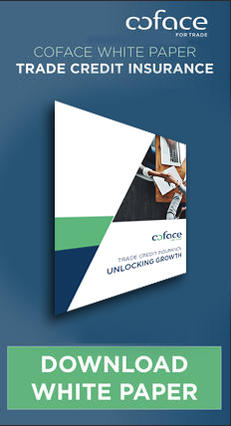Xavier Durand: “We’re seeing a wall of debt coming up with substantial due dates in 2025” - Part 2

This is the second part of Coface' CEO Xavier Durand's interview for French media L'Agefi. Find the first part here.
How far will the normaliZation of corporate insolvencies go?
It’s really tough to predict because when politicians and central banks intervene, it’s based on a frame of reference that it’s hard to get right: Keeping inflation at bay while making sure you don’t create an enormous recession. The key question is knowing how far things will go given that it takes time to transmit monetary policy to the real economy. It’s been 18 months now since rates have been climbing, and inflation is only starting to come back down. The aim is to ensure that there’s a soft landing. But, in reality, we are seeing worldwide growth slowing down to 2.2% in 2024, which is historically relatively low.
How is access to financing changing?
Companies have been financing themselves cheaply for years. From now on, cost conditions and financing volumes aren’t so good. Businesses benefited from government support during the recent crises, but here’s a question: Did they take the opportunity to revise their business model? Or are they still operating on borrowed time, and won’t be able to repay their debts just with their cash flow? It’s all about knowing which companies fall into which category.
Around two-thirds of loans backed by state guarantees are still outstanding; so this is still a form of support compared to current financing conditions. But from next year, so-called “zombie” companies will be faced with a refinancing brick wall that some of them will have difficulty getting through. Market logic will get the upper hand again, and new winners and losers from the crisis will emerge.
“We’re seeing a wall of debt coming up with substantial due dates in 2025”
Admittedly, corporate margins are still good, as are cash flows, which is why monetary tightening takes time in an environment where the starting point is positive. And this is especially the case since businesses have secured sources of financing over several years at very low rates.
We’re seeing a wall of debt coming up with substantial due dates in 2025. Everything will hinge on the rate of normalization. For the moment, the level of bankruptcies is still close to the annual averages pre-Covid at around 50,000 a year in France.
Should we be afraid of the investment wall that lies ahead with the ecological and energy transition?
Investment in carbon-free energy has risen sharply in recent years: it’s currently just under two trillion dollars worldwide. But this figure still falls far short if we want to be in step with the Paris Agreement. That’s more than double the investment that would be needed every year up to 2030. The shortfall is still colossal, especially as it needs to be financed under conditions that are a great deal more restrictive than in the past.
All the economic stakeholders will have to lend a hand, and it can only be a collective effort: by states, obviously, which have to create the suitable tax and regulatory framework, but also by households and businesses.
Are companies in a position to tackle these transitions?
It's a complicated transition, and while businesses didn’t wait until 2023 to introduce CSR (social and environmental responsibility) policies, the challenges of the climate emergency have taken on an entirely new dimension over recent years. Climate action is making headway, and regulations and classifications are being introduced, but the framework as a whole is very complex.
When it comes to the ecological transition, not all industries are equal. Some sectors – such as construction – are ahead of the game: they’ve been prodded into action by the regulations in particular. For other industries, their economic model is being seriously challenged; this is the case, for example, with the automobile industry, which is in the process of reinventing itself.
Apart from the stakeholders, of course, the situation facing each company is unique. But they’re all pushing on with restructuring so they can tackle these complex issues that have an impact on their culture and the skills they need to (re)invent. In parallel, they have to be able to meet the new regulatory standards that are becoming increasingly demanding.
The situation is all the more difficult for companies to read since the framework is still a long way from being stabilised at international level. And that assumes an agreement will be struck between states, a target that is not immediately obvious.
But there is another side to the coin: the ecological transition will also create opportunities, such as new kinds of job, new markets and new technologies. The economy is constantly innovating, and the ecological transition is fertile ground for novel solutions.
What action is Coface taking from a CSR perspective in particular?
Coface's CSR strategy is based on three key priorities: as an employer, as a credit insurer and as an organization dedicated to shrinking its own footprint.
As an insurer, we have an investment portfolio worth three billion euros, and we’ve drawn up the rules for investing it responsibly. We calculate its carbon impact, and we’re making sure that it’s steadily going down. We exclude different kinds of business – depending on the taxonomy (such as polluting / unethical industries) – and the ESG (environment, social, governance) rating of our portfolio is getting better year on year.
Our trade policy also provides for restricting or reducing our commitments in fossil fuel-related industries and unethical sectors (weapons banned by the Ottawa Treaty in particular, betting, endangered species, and so forth).
We're also vigilant about the way we handle our operations: reducing the space we occupy, cutting back on travel and an overall reduction in the trips we make thanks to widespread distance working.
Last but not least, we've decided to double the amount of support we give ESG projects by 2025 in the context of our single risk insurance solutions (renewable energy, protecting natural environments, health, etc.).
As a responsible employer, we’re drawing up an HR policy inside Coface that aims to guarantee the well-being of our employees. How? By providing an inclusive, diverse framework that will help them develop. This is a key to the success of our teams, which are made up of over 80 nationalities in 58 different countries. We systematically measure employee engagement, which is followed up with action plans: developing career opportunities through international or functional mobility, for instance, or devising specific training plans for our top talent, in particular by tapping into internal academies that aim to upgrade skills. In addition, we conduct a host of initiatives to promote diversity inside Coface, including gender equality. We're doing everything we can to achieve equal pay in the short term and to step up the representation of women among senior managers: we’re aiming for 40% women by 2030, a target that we’re already on the way to hitting since 36% of senior managers today are women.
How is the role of credit insurance changing in these challenging times?
The world is a more complex and less predictable place. Our role now more than ever is to help our clients navigate these choppy waters safely and securely. Our work typically consists of risk prevention, indemnification and collecting unpaid debts.
We track risk for businesses, something that is even more important today given the major shifts taking place in society. We have built a unique infrastructure to do just this. It ranges from the economic analysis of sectors and countries to retrieving hard data from large-scale balance sheets and operating accounts. Our information base monitors 188 million companies in 200 countries. Our data, our experts and our technology systems incorporate the latest developments in artificial intelligence, and all of this informs our expertise in risk analysis. It’s a profession that calls for an investment capacity, a certain size and a long history of experience and data.
In practice, we develop scoring and tracking tools for businesses so that our clients can monitor their own customers. One of the reasons our offer has grown is because our services are user friendly for our clients. They need to be able to access our data quickly. Five years ago, it took a week to issue a guarantee, whereas today a few hours is all it needs. Connectivity is also a priority, and it has to be optimal.
We've developed a range of information services for three years that complements and is in synergy with our credit insurance business. Our data, which is also used to analyse our own credit obligations, helps clients monitor the risk of their suppliers and customers. It’s useful for searching for trading partners from start to finish.
For small and very small businesses that don’t publish as much data as bigger companies, we have to manage risks with less knowledge. Improving the service we give them is a long-term quest, one where we’re making progress around the clock thanks to the proliferation of data that is available and new technologies. We have to give them a simple, effective solution, and the approach exploits technology not to mention legal and risk analysis. Last of all, you have to find the right distribution channels to stick to the balance between the time spent on sales and the price of the service.
What is the long-term potential of credit insurance?
There aren't very many of us in this highly demanding sector. At the same time, companies need to track their credit risk around the world: it’s estimated that a quarter of all bankruptcies globally are linked to debt problems. And that’s why we play a pivotal role, helping companies prevent risk via credit insurance or by providing data. We also have a factoring business in Germany and Poland, and we support the factors elsewhere.
First and foremost, we are in the business of prevention. Credit insurance is not an expensive product: it represents a few dozen basis points in a company’s turnover. So, to balance premiums received and claims indemnified, you have to find the optimum between the selling price of the service and the level of risk you’re prepared to take. All this means we’re committed to well-designed transactions between the insured and insurer. Our good results at the start of the year were largely due to our fine risk management and prevention.








